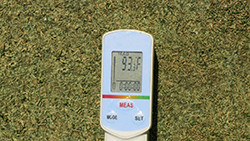Headline: Drought Conditions Impact Golf Courses throughout Massachusetts; Superintendents Faced with Managing Dwindling Water Supplies and Usage Restrictions, With Little or No Relief in Sight
For Immediate Release: August 5, 2016
 |
| Drought conditions and high heat are impacting golf courses across New England. |
 |
Norton, MA — While the dry and warm weather pattern so far this season has been conducive to playing golf and many outdoor activities, the extended lack of rainfall is posing challenges for golf facilities and golf course superintendents throughout the State.
Don Hearn, Executive Director of the Golf Course Superintendents Association of New England (GCSANE) has been working directly with superintendents across the state to determine and help manage the impact of these drought conditions.
“Some have said it is the worst dry spell they’ve experienced,” said Hearn. “There are clubs that have ample water supply, but an inadequate system for delivery, while others have good delivery systems but are forced to reduce irrigation because their supply has been reduced.”
Don D’Errico, Golf Course Superintendent at Spring Valley Country Club, and member of the Board of Directors of GCSANE offered his perspective.
“Many members at our club have commented that they have never seen the ponds so low on the golf course. They have also expressed their concerns with the lack of available water to maintain the turf.”
The USGA’s Green Section and its experts in turf management are closely monitoring the situation both in New England and throughout the entire Northeast region.
“As water supplies are depleted, any issues with water quality can be magnified” cautioned Jim Skorulski, Northeast Region Senior Agronomist with the USGA.
Businesses across the region – including golf course facilities – received notice from the Massachusetts Department of Environmental Protection that a Drought Watch for the Central and Northeast Regions and Drought Advisory for the Connecticut River Valley and Southeast Regions had been declared.
The reason for the declaration was in part due to the fact that “as of June 30, 2016 precipitation, streamflow, and groundwater elevations were below normal throughout most areas of Massachusetts.”
Golf facilities that are permitted by the DEP are required to implement a Drought Management Plan that restrict water usage beyond what they are allowed to use under normal conditions. Facilities that are registered with DEP are currently not required to restrict water usage.
“We encourage all golf courses to take appropriate measures to conserve water,” said Duane LeVangie, Water Management Act Program Chief for the DEP. “We also encourage golf facilities to review their existing permits or registrations and drought plans and to contact our office should there be any question as to how the current conditions may apply to their facility.”
LeVangie also noted that, “it will likely take a significant amount of rain over a period of time to affect the current Watch and Advisory condition.”
The DEP Drought Advisory Task Force will meet next on August 11th to re-assess conditions statewide and consider possible adjustments to the current drought levels.
Information produced by the DEP shows that over 140 public water suppliers in the state have imposed water use restrictions as of August 1st. Those restrictions in many systems have banned automatic irrigation systems entirely or have limited their use to 1 day per week.
Golf course superintendents statewide are managing water restrictions; either as imposed by the DEP or as their local groundwater and surface water supplies dictate.
“We ask for the cooperation and patience from golfers as the drought conditions continue,” said Skorulski. “Golfers who adhere to cart traffic rules developed by their superintendent will significantly reduce the injury to drought stressed fairways and primary rough areas.”
As the drought continues, golfers can expect course conditions to reflect the seasonal color variation that are common in the summer and magnified this year with the lack of rainfall.
While turf that is brown may appear to be dead, it is actually temporarily dormant and the result of a naturally occurring survival response by the plant. Color aside, the playing conditions offered by dry or dormant turf can offer a unique and appealing element to the game as topography, bounce and roll are of greater influence on shot making.
D'Errico noted that his members have been able to benefit from the changing conditions of his Sharon layout.
“There have been literally no complaints regarding the appearance of the course with all of the browning and thinning turf throughout the property and they have actually commented on how fun, interesting and enjoyable the course is to play with the variety of different shot-making options available,” said D'Errico. “I feel that a serious dry spell gives golf course superintendents a fantastic opportunity to prepare a golf course in an environmentally responsible manner, all the while providing the best playing surfaces to their customers.”
Skorulski concurs that while this is a stressful time for turf and superintendents, there is a silver lining for golfers.
“The drought offers a unique opportunity to manage golf courses with less water and for golfers to play firm fairway surfaces,” said Skorulski. “Enjoy the extra ball roll and remain patient while hoping normal precipitation patterns return soon.”
Golf Course Superintendents Association of New England
Contact: donhearn@gcsane.org
Golf Course Superintendents of America
USGA Green Section
Contact: jskorulski@usga.org
USGA Green Section Water Resource Site
Massachusetts DEP Water Management Act Program
Contact: duane.levangie@state.ma.us
Massachusetts Golf Association: www.mgalinks.org
Contact: mgagne@mgalinks.org